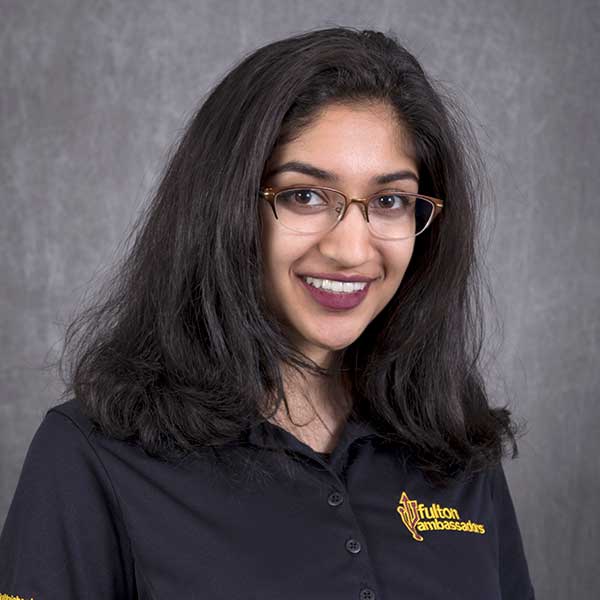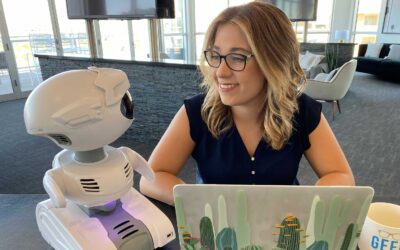ASU engineering student wins stellar intern award
 BY KARISHMA ALBAL
BY KARISHMA ALBAL
Oct 27, 2020

In March 2020, the global pandemic swiftly required much of the workforce to operate remotely. Since then, more and more employees and students have transitioned to working from home, often adjusting to different time zones and technical challenges in the process.
Overcoming the barriers associated with remote work and still contributing to progress in the workplace is no easy feat. But for Janani Anand, a software engineering graduate student in the Ira A. Fulton Schools of Engineering at Arizona State University, it is all about hard work and finding creative solutions.
Anand completed a 13-week internship at Hewlett-Packard this past summer, during which she worked on two projects simultaneously. One involved a new technology called Wi-Fi signature profiling with a team in Houston, Texas, and the other was a machine learning project for HP Labs with a team in Taiwan.
Her efforts were recognized by an HP Intern-Stellar award, which is given to the intern with the best project, for work on Wi-Fi signature profiling.
Problem solving during a pandemic
Anand effectively split her time between the two projects throughout the 13-week internship. However, she considered the Wi-Fi signature profiling project with the team in Houston to be her primary focus.
“Wi-Fi signature helps enhance and change a device’s system settings based on the location around you,” Anand says. “A simple form would try to determine a user’s context, and one of the parameters for that is their location. There are multiple ways to fetch a user’s location, like cellular signals and GPS, and I was primarily working on getting their location using Wi-Fi signals from a computer.”
Anand’s project took place over multiple phases, the first being extensive research on the topic to determine if Wi-Fi was more effective for location tracking than other signals, as well as determining whether offline scans can be performed. Her ultimate goal was to create an end-to-end prototype of an application that uses Wi-Fi signature profiling.
Using rapid prototyping, Anand created an initial model that she could improve later in the project.
With the pandemic, Anand was concerned about not only the risk of exposure but also having to walk around with her computer while scanning for Wi-Fi signals and potentially having to stay in one place for several hours while she collected data.
Looking for an innovative solution to the travel barriers, Anand simulated a location change by collecting data at her own home, her friend’s home on the south side of her apartment complex and another home on the north side of the complex.
“Initially, I just tested my application at two locations,” Anand says. “I ran my application for about six to eight hours and analyzed the data. When I tested it at three locations, I ran the application for about 10 hours.”
The second half of Anand’s project was all about understanding the data she collected, determining if it was reliable and figuring out which outputs were most meaningful.
Each new phase used different technologies and systems, so Anand applied a wide variety of skills and programming languages she learned from her academic experiences at ASU, ranging from C# and Windows to Python and Jupyter Notebook, in order to fulfill the different requirements of her project.
“The thing about data science and AI is that you can get different results and outputs for any small changes that you make to the code,” Anand says. “It’s important to completely understand what you’re doing because even if you were to make the minimum number of samples slightly fewer or greater, you would get a different result. It’s important to spend time analyzing your data in order to see which output is the most meaningful. It requires a lot of trial and error.”
Meeting the challenges of remote work
One of the most difficult aspects of her internship had nothing to do with technical skills she needed to complete both machine learning and Wi-Fi signature profiling.
“My team is based in Houston, Texas,” Anand says. “I was working remotely from Tempe and most of my team meetings would be in a time zone two hours ahead. I used to start very early because an 8 a.m. meeting for them would be 6 a.m. for me.”
Anand’s other project, which involved machine learning for HP Labs, also required her to adjust to another time zone, as her mentors were based in Taiwan. Consequently, she often had late-evening meetings with the team there, followed by early-morning meetings with her team in Houston.
“It took a while to get used to that schedule,” Anand says. “But if you have a lot on your plate, you have to effectively manage your time and maybe put in some extra hours. Working on weekends and putting in the extra effort to research and study topics so the next week would be more productive definitely helped a lot.”
Even with the work-from-home setup, Anand says the one thing that really stood out about HP was the culture of the organization and the warm and welcoming nature of people in the workplace.
“They are very open and inviting. You can message anyone you want and ask for a virtual coffee chat,” Anand says. “Everyone is really encouraging of the work you’re doing. Even though I was working remotely, I still felt really involved in what I was doing.”
Anand participated in virtual intern events as well as in various engagement activities set up by the company. She found roundtables with leaders at HP encouraging and inspirational, and intern engagement events allowed Anand to meet different people and learn about their work.
“When my internship ended, they sent me an HP pen with my name engraved on it, so it felt a lot more personalized,” Anand says. “It speaks a lot about how much they value their employees.”
Researcher
Janani Anand
Graduate student
Software engineering
The Polytechnic School
Related Stories
ASU Innovation Open announces 2021 semifinalists
Student innovators from universities around the world to compete for $300,000 in cash prizes
Vijay Vittal: 15 years of energizing power systems engineering
Vijay Vittal is ending his tenure as director of the Power Systems Engineering Research Center after an impactful 15 years of modernizing the electric grid.
Storytelling robots set to provide dementia relief
New research funded by the Zimin Foundation explores how storytelling robot technology can support older adults with dementia and their caregivers.
Abbas, Friesen earn elevated status among academic inventors
The National Academy of Inventors has named two Fulton Schools faculty members to the August 2020 class of NAI senior members.


